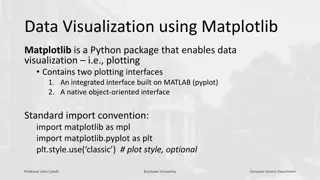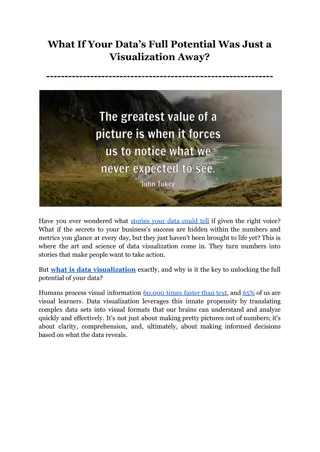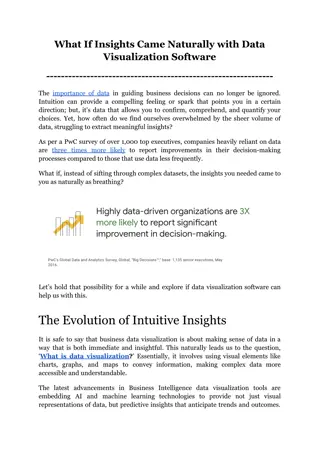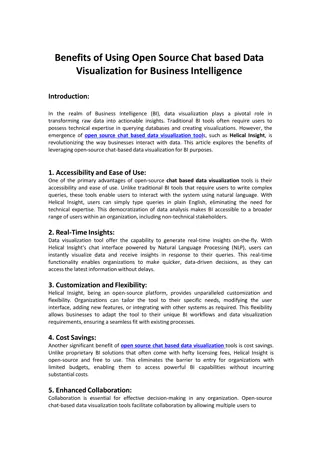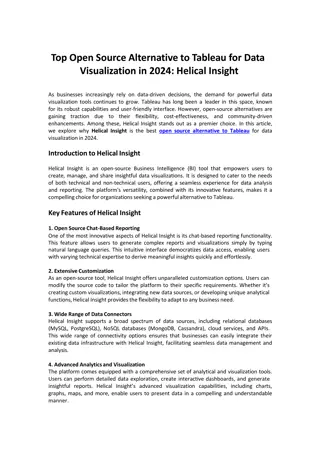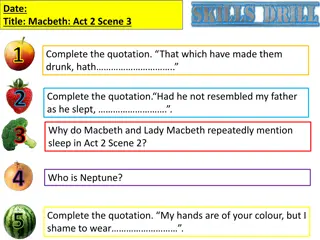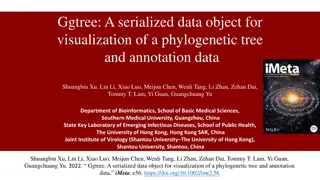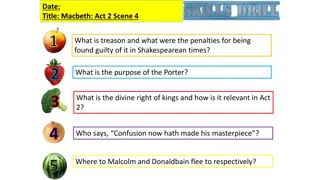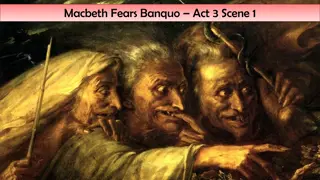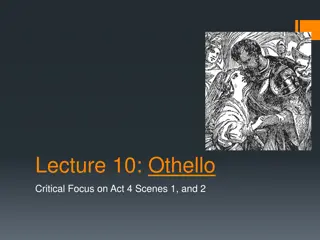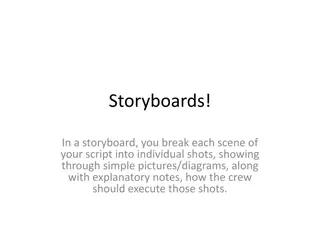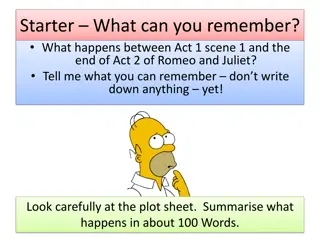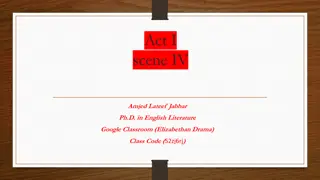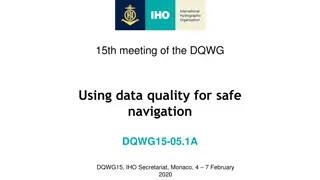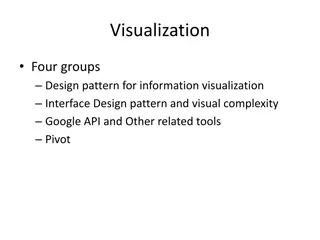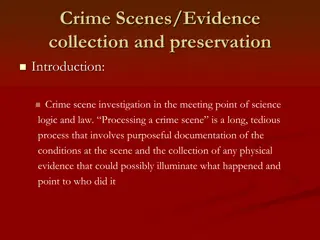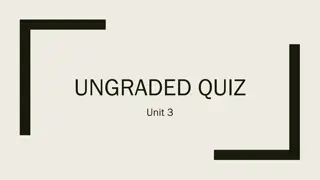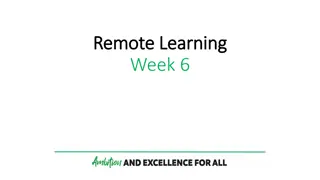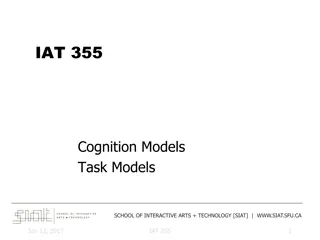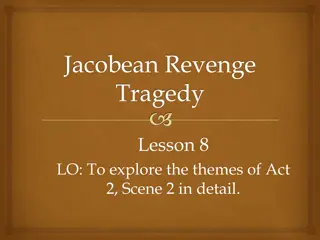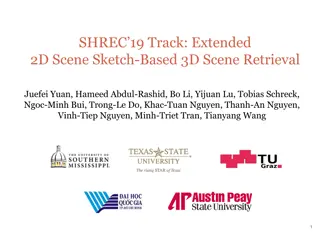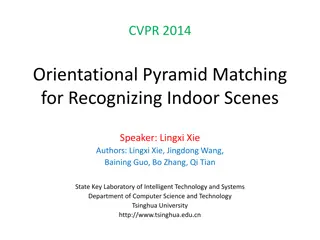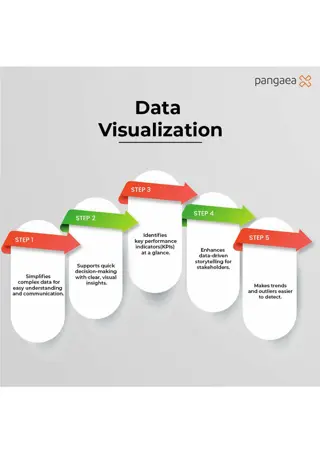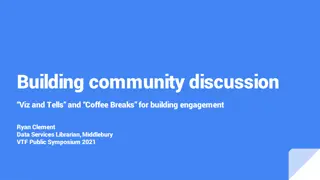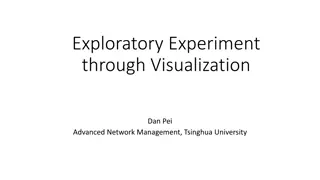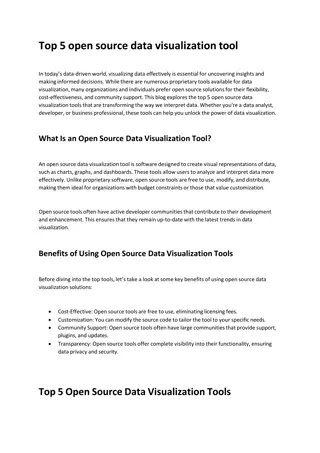Why Most Data Visualization Dashboards Fail — And How to Make Yours Succeed
Embrace the opportunity to see how Grow can transform your business data visualization strategy with a 14-day free trial.
2 views • 4 slides
Data Visualization with Matplotlib in Python
Matplotlib is a powerful Python package for data visualization, offering both an integrated interface (pyplot) and a native object-oriented interface. This tool enables users to create various types of plots and gives control over the visualization process. Learn about basic operations, differences
7 views • 19 slides
What If Your Data’s Full Potential Was Just a Visualization Away_
Discover what is data visualization and how it can reveal your data\u2019s full potential, guiding you towards more informed decisions and a brighter business future. Let\u2019s dive right in!
1 views • 6 slides
What If Insights Came Naturally with Data Visualization Software
In an era where data is as vital as currency, the power to swiftly unlock and act on its hidden insights could be the key to unlocking unprecedented growth and innovation. Imagine a world where data visualization software not only presents data but intuitively guides you to the insights buried withi
1 views • 6 slides
Open Source Chat Based Data Visualization With Helical Insight
Open Source Chat Based Data Visualization plays a pivotal role in modern business operations, enabling organizations to derive insights, make informed decisions, and drive growth. However, traditional visualization tools often come with high costs and steep learning curves, limiting accessibility an
1 views • 2 slides
CSI Unit Final Project: Mini Crime Scene Challenge
Create a mini crime scene using what you've learned during the CSI unit to challenge your classmates. Your team will have four class periods to complete the project, including a case briefing, the crime scene setup, evidence collection, and a case summary. Remember to include descriptions of the cri
0 views • 12 slides
Benefits of Open Source Chat-based Data Visualization
In the realm of Business Intelligence (BI), data visualization plays a pivotal role in transforming raw data into actionable insights. Traditional BI tools often require users to possess technical expertise in querying databases and creating visualizations. However, the emergence of open source chat
1 views • 2 slides
Open Source Alternative to Tableau for Data Visualization in 2024
As businesses increasingly rely on data-driven decisions, the demand for powerful data visualization tools continues to grow. Tableau has long been a leader in this space, known for its robust capabilities and user-friendly interface. However, open-source alternatives are gaining traction due to the
0 views • 2 slides
Discovering the Porter in Macbeth's Act 2 Scene 3
Act 2 Scene 3 of Macbeth features the Porter's comedic interlude, providing relief from the tense atmosphere following Duncan's murder. The Porter's dialogue, filled with humorous references and wordplay, adds a layer of complexity to the play's themes. This scene contributes to building suspense an
2 views • 9 slides
Reusing Phylogenetic Data for Enhanced Visualization and Analysis
Reusing phylogenetic data can revolutionize scientific research by enabling synthesis of knowledge and comparative analyses across scientific disciplines. However, a significant portion of valuable phylogenetic data is lost due to the prevalent use of static images for tree publication. To address t
0 views • 8 slides
Wind Tunnels: Devices for Aerodynamic Testing
Wind tunnels are devices that simulate air flows to test models under controlled conditions. They are classified as low-speed and high-speed tunnels, used to replicate flying or moving objects. Testing involves studying air motion using techniques like smoke visualization, colored threads, and speci
2 views • 37 slides
Shakespeare's Macbeth: Act 2 Scene 4 Analysis
This analysis delves into Act 2 Scene 4 of Shakespeare's Macbeth, covering themes of treason, divine right of kings, and the role of the Porter. It explores the unnatural events surrounding Duncan's murder, the symbolic significance of animals, and the tension-building elements in the scene. The use
0 views • 6 slides
Analyzing Macbeth's Fear of Banquo in Act 3, Scene 1
In Act 3, Scene 1 of Macbeth, Macbeth expresses his fears about Banquo and his descendants. He worries about losing the crown and the consequences of his actions. Macbeth's fear of Banquo's lineage and his ambition for his own power are highlighted in this scene. The analysis delves into Macbeth's c
0 views • 15 slides
Interactive Plotting with ggplot and Shiny: Enhancing Galaxy Visualization Tools
Explore the concept of transforming existing ggplot2 Galaxy tools into interactive platforms using Shiny or Plotly implementations. Discover a variety of plot types available with ggplot2, such as barplots, violin plots, PCA plots, and heatmaps. Utilize additional plot options through various geom_*
3 views • 9 slides
Macbeth: Act 3, Scene 4 Analysis and Quotations
Dive into Act 3, Scene 4 of Macbeth where Macbeth encounters Banquo's ghost at a banquet. Explore key questions, comprehension queries, and an analysis of significant quotations related to the scene's language and context.
0 views • 16 slides
EEG Conformer: Convolutional Transformer for EEG Decoding and Visualization
This study introduces the EEG Conformer, a Convolutional Transformer model designed for EEG decoding and visualization. The research presents a cutting-edge approach in neural systems and rehabilitation engineering, offering advancements in EEG analysis techniques. By combining convolutional neural
1 views • 6 slides
Analysis of Othello's Downfall in Act 4 Scenes 1 and 2
In Act 4 Scene 1 of Othello, Iago manipulates Othello into believing in Desdemona's infidelity, intensifying Othello's jealousy and rage. The scene culminates in Othello publicly striking Desdemona, showcasing the depths of his descent into corruption. Meanwhile, Act 4 Scene 2 portrays Othello's com
1 views • 49 slides
Mastering Storyboarding: A Comprehensive Guide for Effective Scene Visualization
Understanding how to create impactful storyboards is crucial for bringing scripts to life. This guide delves into breaking down each scene into shots, conveying audience emotions, and making shot-by-shot creative decisions. Learn how to craft storyboards that effectively communicate your vision to t
0 views • 12 slides
Analysis of Conflict and Character Development in Romeo and Juliet Act 3 Scene 1
Act 3 Scene 1 of Romeo and Juliet delves into the escalating conflict between the Montagues and Capulets, showcasing how external factors influence character behavior. The scene unfolds in a public setting, highlighting the shift from humor to tragedy as Mercutio and Tybalt engage in a fatal duel. T
11 views • 16 slides
Design and Evaluation in Visualization Techniques
Understanding the importance of formal evaluations in visualization techniques, this material covers a range of evaluation methods including empirical and analytic approaches such as usability tests, controlled experiments, and expert reviews. It delves into the scientific method of hypothesis forma
1 views • 41 slides
Analysis of Act I Scene IV in Hamlet: Themes and Symbolism
Hamlet waits on the castle battlements for the ghost of the dead king to appear. Despite objections, he follows the ghost, setting a tone of nervous anticipation. The scene contrasts domestic and military settings, emphasizing urgency. The sound of cannon signals excessive drinking and partying at C
0 views • 15 slides
Multidimensional Icons in Data Visualization Solutions
This collection showcases various types of visual icons used in data visualization to represent values of different variables, such as categorical, quantitative, and Boolean data. Each icon summarizes specific information for a given item in a collection, ranging from nominal and ordinal data to the
0 views • 9 slides
Enhancing Safety in Navigation Through Improved Data Quality Visualization
The IHO Data Quality Working Group focuses on classifying and depicting the quality of digital hydrographic information to ensure safe navigation. The group addresses the need for clear warnings on ECDIS displays regarding poor-quality survey data. Despite progress in developing visualization method
1 views • 34 slides
Software Design Patterns for Information Visualization
Explore design patterns for information visualization interfaces, understand the complexities, and leverage tools like Google API. Learn about different software design patterns, categories of patterns for information visualization, and the relationships between them. Discover the reference model fo
0 views • 27 slides
Crime Scene Investigations Through Animal Evidence
Explore the role of animals in crime scene investigations, from using pigs as corpse models to analyzing evidence left behind by animals like flies, crows, and foxes. Learn how different types of evidence, such as plant DNA and bullet wounds, can provide valuable insights for investigators. Discover
0 views • 6 slides
Crime Scenes and Evidence Collection: The Intersection of Science, Logic, and Law
Crime scene investigation is a meticulous process that involves documenting the scene conditions and collecting physical evidence to unravel the truth behind a crime. Understanding what constitutes a crime scene, the importance of evidence, conducting initial surveys, taking precautions, and conduct
0 views • 40 slides
Interactive Data Visualization Tools and Techniques Quiz
This quiz tests knowledge on data visualization tools, techniques, and concepts. Questions cover topics such as the use of EDA in data visualization, interactive graph outputs, historical figures in data visualization, GIS data types in SAS/JMP, outlier detection in 3D scatterplots, and limitations
1 views • 11 slides
Act 2 Scene 3: The Role of the Nurse in Shakespeare's Romeo and Juliet
Act 2 Scene 3 of Shakespeare's Romeo and Juliet introduces the character of the Nurse, who serves as a confidante and maternal figure to Juliet. The Nurse's role in facilitating the relationship between Romeo and Juliet is crucial, and her bawdy nature adds depth to the play's dynamics. This scene a
0 views • 18 slides
Cognition Models in InfoVis: Understanding Knowledge Creation Process
Visualization plays a key role in aiding cognition by supporting knowledge creation and seeking tasks through process models and task taxonomies. Understanding the cognitive aspects of information visualization is crucial for aiding comprehension and knowledge understanding, as demonstrated by the u
0 views • 41 slides
Enhancing Classmate's Data Visualization for Homework Assignment 2
Explore the process of applying a classmate's data visualization code to your own data for Homework Assignment 2. Critique the effectiveness of the visualization in conveying the intended point and offer suggestions for improvement if necessary. Follow the steps outlined to submit your completed ass
0 views • 4 slides
Analysis of Act I, Scene II in Shakespeare's Hamlet
The scene delves into complex themes such as royalty, grief, revenge, and morality, focusing on Hamlet's internal struggles and interactions with other characters. It highlights Hamlet's melancholic nature, his relationships with his mother and deceased father, and introduces key questions surroundi
0 views • 17 slides
Themes in Act 2, Scene 2 of Jacobean Revenge Tragedy
Act 2, Scene 2 delves into the unfolding drama at the Duchess's palace, revealing suspicions of the Duchess's pregnancy, accusations of theft, and the birth of a son amidst intrigue and betrayal. This scene showcases themes of suspicion, trust, superstition, and deception, setting the stage for furt
0 views • 11 slides
SHREC19 Track: Extended 2D Scene Sketch-Based 3D Scene Retrieval Overview
The SHREC19 Track focuses on Extended 2D Scene Sketch-Based 3D Scene Retrieval, aiming to retrieve relevant 3D scene models using scene sketches as input. This challenging research direction addresses the semantic gap between 2D sketches and accurate 3D scene models, with vast applications in 3D sce
0 views • 29 slides
Orientational Pyramid Matching for Indoor Scene Recognition at CVPR 2014
This presentation at CVPR 2014 introduces Orientational Pyramid Matching for recognizing indoor scenes. The speaker, Lingxi Xie, along with other authors, presents the Bag-of-Feature Model and its experimental results. The focus is on scene recognition and the importance of image understanding in va
0 views • 39 slides
Maximize Business Impact with Data Visualization
This infographic shows how data visualization simplifies complex data, supports decision-making, highlights KPIs, and enhances data-driven storytelling. Its an essential tool for identifying trends and outliers. Discover expert data visualization talent at Pangaea X by visiting www.pangaeax.com.
7 views • 1 slides
Data Visualization Presentations Collection
Collection of various image slides containing charts, graphs, and data visualization elements. The slides showcase different types of visual representations such as bar graphs, line charts, percentages, and more. Each slide provides a unique visualization, making it a diverse collection for presenta
0 views • 13 slides
Effective Stakeholder Interviews for Visualization Tool Improvement
Conducting in-depth interviews with stakeholders is crucial for identifying their needs and use cases for visualization tools. By asking targeted questions and analyzing responses, insights can be gained to enhance the current visualization technique, like Eiffel Vici. The process involves mapping s
0 views • 5 slides
Enhancing Data Visualization Community Engagement through Viz and Tell Sessions
This resource outlines a model for building a critical community focused on data visualization, offering Viz and Tell/Coffee Break sessions to encourage engagement and learning. Topics covered include visualization instruction, tools, ethics, data journalism, and more. The model emphasizes open disc
0 views • 6 slides
Importance of Data Visualization in Network Management
Data visualization plays a crucial role in understanding and extracting value from data, especially in the realm of network management. Visualization techniques enable better decision-making, pattern recognition, and storytelling with data. By exploring data through visualization tools, one can unco
0 views • 26 slides
Top 5 Open Source Data Visualization Tools
This blog explores the top 5 open source data visualization tools that are transforming the way we interpret data. Whether you're a data analyst, developer, or business professional, these tools can help you unlock the power of data visualization.
0 views • 5 slides

